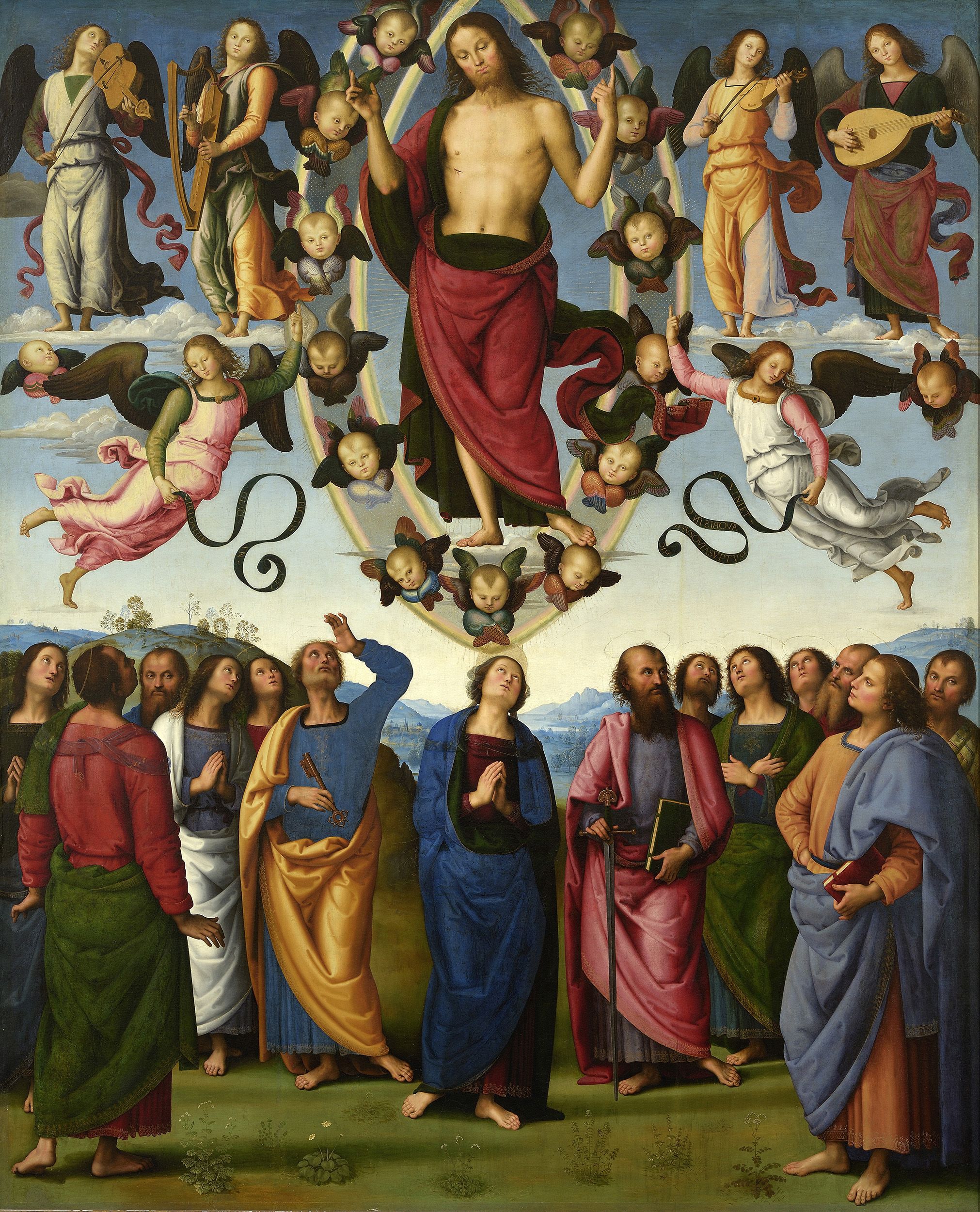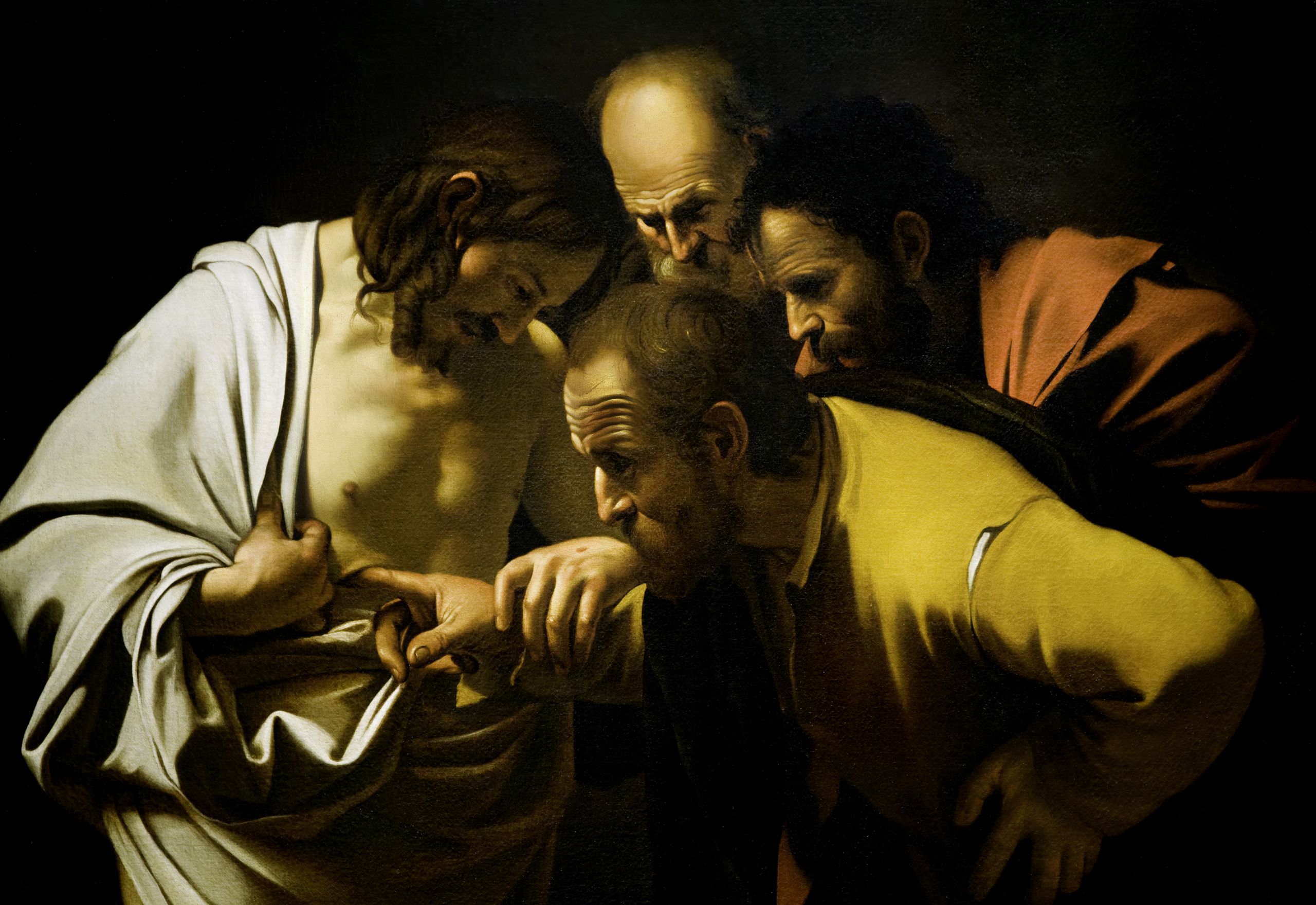Return to Life
The Art of Scripture

During the 50 Days of Easter leading up to Pentecost, Christ sends His Spirit to all humanity, and we witness a series of significant post Easter experiences in the life of Christ; His appearance to St Thomas and the Disciples on the way to Emmaus and His glorious Ascension. This digital story (as part of St James's News) reflects upon those events witin the Scriptures of St Luke and the Acts. Each scriptural reading is accompanied by art historical representation throughout the ages.
Thomas
The Act of Faith

In all the accounts of Jesus’s post-Easter appearances perhaps the easiest for us to identify with is that to Saint Thomas. For some unexplained reason he was not with the others when Jesus first appeared to the disciples as a group and Thomas just could not accept their testimony. He had seen death – he knew its irreversibility. Grief must have turned his friends’ minds: they were seeing what they wanted to see, imagining what they so desperately wanted to imagine.
“Unless I see the holes that the nails made in his hands and can put my finger into the holes they made and unless I can put my hand into his side, I refuse to believe”

A week later that was Thomas’s exact experience. In the radiance of Jesus’s presence doubt turns into conviction. “My Lord and my God”: the act of faith echoes down through the centuries. What hit Thomas so forcefully was the substantial reality that confronted him. He could not explain, but he could no longer deny. This was the same bodily reality he had known from the previous three years. Jesus spoke to him, invited his touch, wanted to eat and drink with him. “The resurrection tells us that something has happened so world-shaking that from now on everything else we know about reality must be related to this, not the other way round”.
In encountering the glorified reality of Jesus, Thomas saw a body still wounded by the suffering which had been imposed on it during the horrors of Good Friday. Yes, the power of the grave had been broken once and for all, but the cost involved is destined never to be eradicated and the marks in the flesh of Jesus remain eternally part of the Godhead.
Emmaus
Recognition

The Story of Emmaus
The meetings on the road to Emmaus and subsequent supper at Emmaus has also been popularly represented in Art. As in the story of St Thomas, each disciple experiences an evolution of awareness from despair over Christ's death to faith in his resurrection.
Two of Jesus’ followers left Jerusalem to return home to Emmaus. On the way, they were met by Jesus, however, they did not recognize Him at first. After they had dinner together, Jesus revealed to them who He was. Jesus left them and they returned to Jerusalem to tell the Disciples what they had seen. (Luke 24:13-35).
Luke 24:13-35
Now that same day two of them were going to a village called Emmaus, about seven miles from Jerusalem.
14 They were talking with each other about everything that had happened.
15 As they talked and discussed these things with each other, Jesus himself came up and walked along with them;
16 but they were kept from recognizing him.
17 He asked them, “What are you discussing together as you walk along?” They stood still, their faces downcast.
18 One of them, named Cleopas, asked him, “Are you the only one visiting Jerusalem who does not know the things that have happened there in these days?”
19 “What things?” he asked.“About Jesus of Nazareth,” they replied. “He was a prophet, powerful in word and deed before God and all the people.
20 The chief priests and our rulers handed him over to be sentenced to death, and they crucified him;
21 but we had hoped that he was the one who was going to redeem Israel. And what is more, it is the third day since all this took place.
22 In addition, some of our women amazed us. They went to the tomb early this morning
23 but didn’t find his body. They came and told us that they had seen a vision of angels, who said he was alive.
24 Then some of our companions went to the tomb and found it just as the women had said, but they did not see Jesus.”
25 He said to them, “How foolish you are, and how slow to believe all that the prophets have spoken!
26 Did not the Messiah have to suffer these things and then enter his glory?”
27 And beginning with Moses and all the Prophets, he explained to them what was said in all the Scriptures concerning himself.
28 As they approached the village to which they were going, Jesus continued on as if he were going farther.
29 But they urged him strongly, “Stay with us, for it is nearly evening; the day is almost over.” So he went in to stay with them.
30 When he was at the table with them, he took bread, gave thanks, broke it and began to give it to them.
31 Then their eyes were opened and they recognized him, and he disappeared from their sight.
32 They asked each other, “Were not our hearts burning within us while he talked with us on the road and opened the Scriptures to us?”
33 They got up and returned at once to Jerusalem. There they found the Eleven and those with them, assembled together
34 and saying, “It is true! The Lord has risen and has appeared to Simon.”
35 Then the two told what had happened on the way, and how Jesus was recognized by them when he broke the bread.




Ascension
'You shall see the Angels Ascending'
John 1:51

Ascension
Luke–Acts, a single work from the same anonymous author, provides the only original narrative account of the Ascension.
Luke, chapter 24:44-53, tells how Jesus leads the eleven disciples to Bethany, a village on the Mount of Olives, where he instructs them to remain in Jerusalem until the coming of the Holy Spirit.

John Singleton Copley, Ascension
John Singleton Copley, Ascension
Acts 1:1-11
1 In the first book, Theophilus, I dealt with all that Jesus did and taught
2 until the day he was taken up, after giving instructions through the Holy Spirit to the apostles whom he had chosen.
3 He presented himself alive to them by many proofs after he had suffered, appearing to them during forty days and speaking about the kingdom of God.
4 While meeting with them, he enjoined them not to depart from Jerusalem, but to wait for “the promise of the Father about which you have heard me speak;
5 for John baptized with water, but in a few days you will be baptized with the Holy Spirit.”
The ascension
6 When they had gathered together they asked him, “Lord, are you at this time going to restore the kingdom to Israel?”
7 He answered them, “It is not for you to know the times or seasons that the Father has established by his own authority.
8 But you will receive power when the Holy Spirit comes upon you, and you will be my witnesses in Jerusalem, throughout Judea and Samaria, and to the ends of the earth.”
9 When he had said this, as they were looking on, he was lifted up, and a cloud took him from their sight.
10 While they were looking intently at the sky as he was going, suddenly two men dressed in white garments stood beside them.
11 They said:
“Men of Galilee, why are you standing there looking at the sky? This Jesus who has been taken up from you into heaven will return in the same way as you have seen him going into heaven”



Pentecost
The Feast of Pentecost or the Descent of the Holy Spirit, is celebrated on the 50th day (the seventh Sunday) from Easter Sunday. It commemorates the descent of the Holy Spirit upon the Apostles, the Blessed Virgin Mary and other followers of Jesus Christ while they were in Jerusalem celebrating the Feast of Weeks, as described in the Acts of the Apostles (Acts 2:1–31).
Acts 2:1-11
When the time for Pentecost was fulfilled, they were all in one place together. And suddenly there came from the sky, a noise like a strong driving wind, and it filled the entire house in which they were. Then there appeared to them tongues as of fire, which parted and came to rest on each one of them. And they were all filled with the Holy Spirit and began to speak in different tongues, as the Spirit enabled them to proclaim.
Now there were devout Jews from every nation under heaven staying in Jerusalem. At this sound, they gathered in a large crowd, but they were confused because each one heard them speaking in his own language. They were astounded, and in amazement they asked:
"Are not all these people who are speaking Galileans? Then how does each of us hear them in his native language? We are Parthians, Medes, and Elamites, inhabitants of Mesopotamia, Judea and Cappadocia, Pontus and Asia, Phrygia and Pamphylia, Egypt and the districts of Libya near Cyrene, as well as travelers from Rome, both Jews and converts to Judaism, Cretans and Arabs, yet we hear them speaking in our own tongues of the mighty acts of God.'


Return to Life
The Art of Scripture
Pietro Perugino, San Pietro Polyptych, 1496–1500. Caravaggio, The Incredulity of Saint Thomas, 1601-1602, Sanssouci, Potsdam. Matthias Stom, Supper at Emmaus with candlelight, 17th Century, Musée de Grenoble. Caravaggio, Supper at Emmaus, 1606, Pinacoteca di Brera, Milan. Rembrandt, The Supper at Emmaus, 1629, Musée Jacquemart-André. Caravaggio, The Supper at Emmaus, 1601, National Gallery London. John Singleton Copley, Ascension, 1775, Museum of Fine Arts. Plaque with the Pentecost ca. 1150–75, MET. Bernini, Holy Spirit (Saint Peter's Basilica), 1600s (photo by Paolo Gallo Modena ©2018). Titian, The Descent of the Holy Spirit, 1545, Santa Maria della Salute, Venice. Pentecost, Folio 14v of the Rabbula Gospels, ca 586, Biblioteca Mediceo Laurenziana, Florence.
